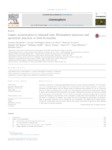Please use this identifier to cite or link to this item:
http://www.alice.cnptia.embrapa.br/alice/handle/doc/1060600| Title: | Copper accumulation in vineyard soils: Rhizosphere processes and agronomic practices to limit its toxicity. |
| Authors: | BRUNETTO, G.  MELO, G. W. B. de   TERZANO, R.   DEL BUONO, D.   ASTOLFI, S.   TOMASI, N.   PII, Y.   MIMMO, T.   CESCO, S.   |
| Affiliation: | Gustavo Brunetto, Departament of Soil Science, Federal University of Santa Maria, 97105-900, Santa Maria, Rio Grande do Sul, Brazil GEORGE WELLINGTON BASTOS DE MELO, CNPUV Roberto Terzano, Dipartimento di Scienze del Suolo, della Pianta e degli Alimenti, University of Bari “Aldo Moro”, I-70126, Bari, Italy DANIEL DEL BUONO, Dipartimento di Scienze Agrarie, Alimentari e Ambientali, Universita degli Studi di Perugia, Borgo XX Giugno 74, 06121 Perugia, Italy Stefania Astolfi, Department of Agricultural and Forestry Sciences (DAFNE), Universita della Tuscia, Viterbo, I-01100, Italy Nicola Tomasi, Dipartimento di Scienze Agrarie e Ambientali, University of Udine, I-33100, Udine, Italy Youry Pii, Faculty of Science and Technology, Free University of Bolzano, Piazza Universita 5, 39100, Bolzano, Italy Tanja Mimmo, Faculty of Science and Technology, Free University of Bolzano, Piazza Universita 5, 39100, Bolzano, Italy Stefano Cesco, Faculty of Science and Technology, Free University of Bolzano, Piazza Universita 5, 39100, Bolzano, Italy. |
| Date Issued: | 2016 |
| Citation: | Chemosphere, v. 162, p. 293-307, 2016. |
| Description: | Viticulture represents an important agricultural practice in many countries worldwide. Yet, the continuous use of fungicides has caused copper (Cu) accumulation in soils, which represent a major environmental and toxicological concern. Despite being an important micronutrient, Cu can be a potential toxicant at high concentrations since it may cause morphological, anatomical and physiological changes in plants, decreasing both food productivity and quality. Rhizosphere processes can, however, actively control the uptake and translocation of Cu in plants. In particular, root exudates affecting the chemical, physical and biological characteristics of the rhizosphere, might reduce the availability of Cu in the soil and hence its absorption. In addition, this review will aim at discussing the advantages and disadvantages of agronomic practices, such as liming, the use of pesticides, the application of organic matter, biochar and coal fly ashes, the inoculation with bacteria and/or mycorrhizal fungi and the intercropping, in alleviating Cu toxicity symptoms. |
| Thesagro: | Cobre |
| NAL Thesaurus: | Copper Vineyard soils |
| Keywords: | Processos da rizosfera Solos de vinhedos Cu toxicidade Cu toxicity Rhizosphere processes |
| Type of Material: | Artigo de periódico |
| Access: | openAccess |
| Appears in Collections: | Artigo em periódico indexado (CNPUV)  |
Files in This Item:
| File | Description | Size | Format | |
|---|---|---|---|---|
| AS3977946459545611471853042511content1.pdf | 544.69 kB | Adobe PDF |  View/Open |









